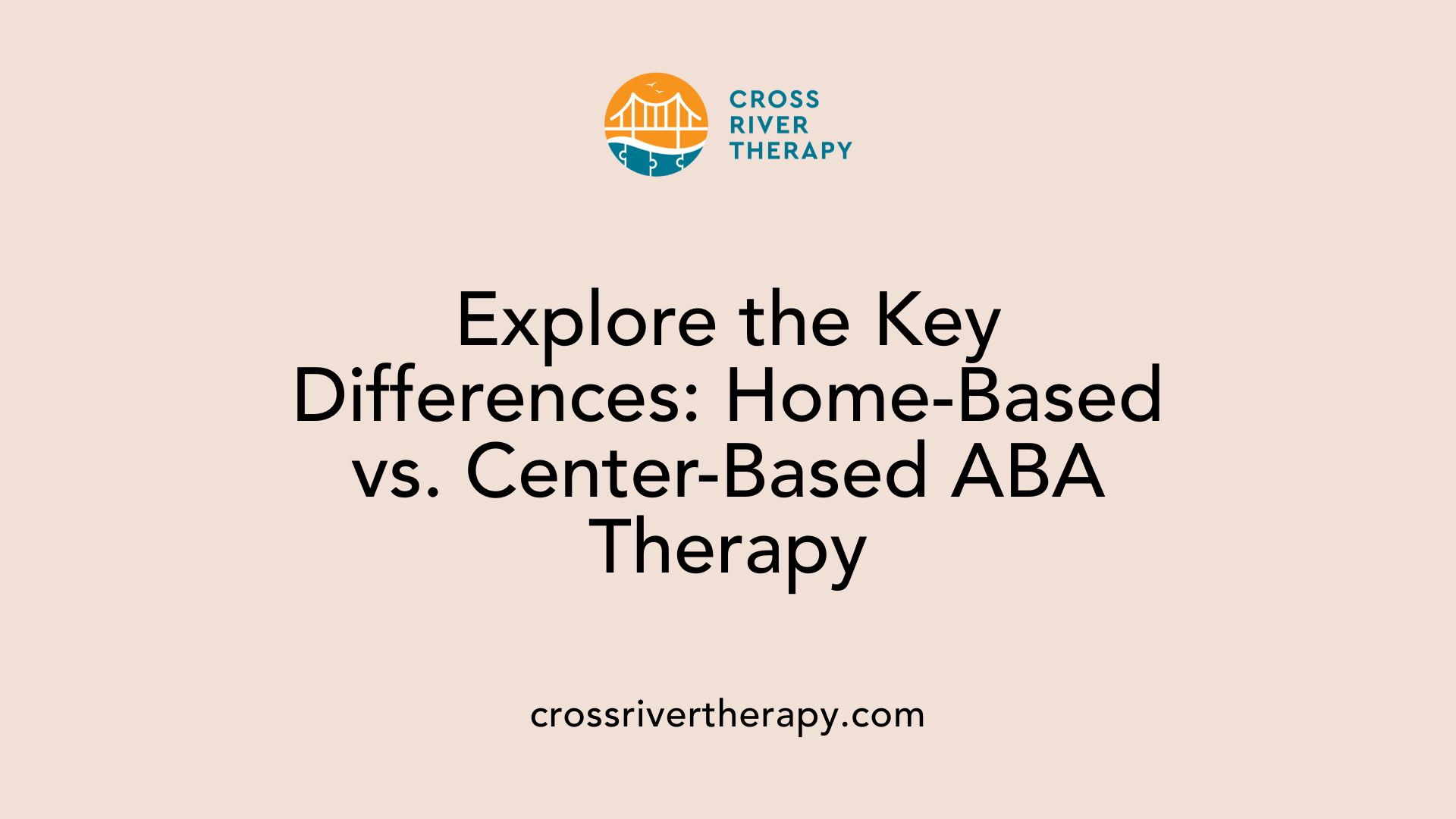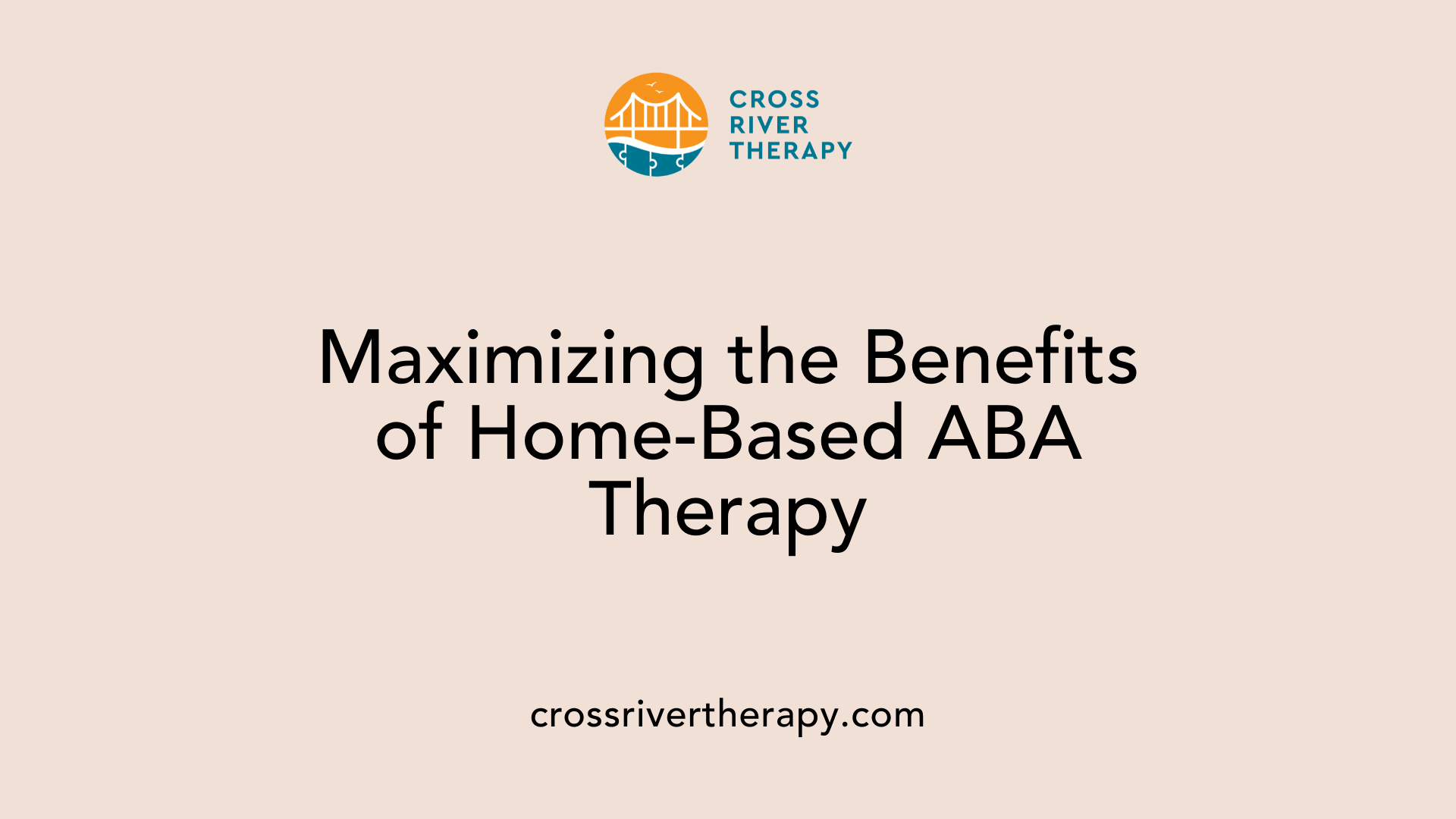Tips for Transitioning from At-Home to Center-Based ABA Therapy
Navigating the Shift: From Home to Center-Based ABA Therapy
Understanding the Transition
Transitioning a child from at-home to center-based ABA therapy is a significant decision that requires thoughtful preparation. Each setting offers unique benefits tailored to different aspects of a child's development. Understanding these differences can support parents and caregivers in making informed choices to best meet their child's needs.
Understanding Therapy Environments

What are the differences between home-based and center-based ABA therapy?
When choosing between home-based and center-based ABA therapy, it’s essential to consider the specific needs of the child. Home-based ABA therapy occurs in a familiar environment, fostering a sense of security. This setting allows children to practice new skills integrated into their daily routines, enhancing their learning in real-life situations.
In contrast, center-based ABA therapy provides a structured and controlled environment aimed at minimizing distractions. This often benefits children who thrive on routines and need a focused atmosphere to build skills, particularly pre-academic ones like attention and orientation. Moreover, center-based settings typically offer a wealth of resources, including access to multidisciplinary professionals that may enhance the overall quality of care.
How do I determine suitability based on my child’s needs?
Deciding which therapy environment is best varies based on the child's temperament and family circumstances. For children requiring foundation skills related to home life, in-home therapy has advantages, allowing skill application in context. However, if social skills and interactions with peers are priorities, center-based therapy can better facilitate these experiences.
Transitioning between both environments is an option and should be approached with planning and support from a child’s Board Certified Behavior Analyst (BCBA), ensuring that the child’s evolving needs are met effectively.
Defining ABA Therapy Duration

Factors Influencing the Length of ABA Therapy
The length of ABA therapy a child may require is often driven by various individual factors. Key considerations include:
- Individual Needs: Each child has unique developmental needs that can influence how long therapy is necessary. This may involve specific behavioral challenges, social skills deficits, or communication difficulties.
- Progress Evaluation: Regular assessments allow therapists to track progress and adjust therapy plans accordingly. If a child shows substantial improvement, the duration may be shortened.
- Intensity of Services: Many children receive therapy ranging from 25 to 40 hours weekly, impacting how long they remain in treatment.
- Family Involvement: Parental engagement in therapy can significantly improve outcomes. Families trained in effective ABA techniques often see faster progress in their children.
Typical Durations and Individualized Approaches
Although there’s flexibility, most children engage in ABA therapy for an average of 2 to 3 years. Here’s a closer look at the typical duration:
| Duration Type | Typical Length | Notes |
|---|---|---|
| Initial Treatment Plan | 1 to 3 years | Personalized based on child’s needs and progress goals. |
| Weekly Therapy Hours | 25 to 40 hours | Intensity can affect overall duration in therapy. |
| Regular Progress Assessments | Ongoing | Necessary to adapt goals and determine continued needs for ABA therapy. |
In conclusion, deciding how long a child should stay in ABA therapy requires a collaborative approach involving parents, therapists, and other support staff, ensuring that the focus remains on the child's unique developmental needs and accomplishments.
Core Principles of ABA Therapy

What are the key principles of ABA therapy?
Applied Behavior Analysis (ABA) therapy is fundamentally defined by seven core dimensions that govern its approach. These dimensions ensure that the therapy is effective and tailored to the needs of individuals learning new behaviors.
- Applied: This dimension focuses on behaviors that are socially significant, actively enhancing the quality of life for individuals.
- Behavioral: ABA emphasizes observable and measurable behaviors, ensuring that progress can be objectively tracked.
- Analytic: Interventions must be based on data and evidence, showcasing clear analyses of the effectiveness of strategies employed.
- Technological: Techniques used in ABA must be explicitly detailed, enabling others to replicate them consistently.
- Conceptually Systematic: All strategies should be based on established ABA principles, maintaining theoretical integrity throughout the practice.
- Effective: The results of interventions must yield significant improvements in the targeted behaviors.
- Generality: Finally, skills learned during therapy should generalize across different contexts, ensuring that the child can apply them in real-life situations.
How does ABA therapy impact transition strategies?
Transitioning from ABA therapy to school programs emphasizes several factors, ensuring a seamless integration of learned skills into educational settings. Preparing for this transition begins 9-12 months prior, focusing on essential classroom skills such as group work and maintaining independence.
In order to enhance this process, a service plan plays a critical role, outlining ancillary services and ensuring effective communication between ABA providers and school personnel. Parents are integral to the transition, participating in meetings to discuss the child's strengths and training needs for educators.
Through careful planning, including pre-meeting discussions about safety risks and training requirements, families can set the stage for a successful transition to school, maximizing the child's ability to apply learned skills effectively in a new environment.
Ensuring Successful Transitions

What are effective strategies for ensuring successful transitions in ABA therapy?
Successful transitions in ABA therapy require thoughtful strategies tailored to the child's unique needs. Families play an essential role in this process, which begins with proactive planning. Engaging in discussions with both ABA providers and school staff allows for a seamless exchange of information about the child's progress and necessary accommodations.
One effective tactic involves using a technique often referred to as the ‘therapist eyes.’ This means parents and caregivers should observe the child's environment closely, identifying potential triggers or distractions that may arise during transitions. Monitoring the child's mood during these periods—especially in new or challenging social situations—provides essential insights into their comfort level and readiness for change.
Role of proactive observation
Proactive observation facilitates smoother transitions by allowing parents to anticipate challenges. Consider the following strategies to enhance the observation process:
- Scan the environment: Identify possible distractions in the surroundings that might impact the child’s focus.
- Monitor mood changes: Note fluctuations in behavior during various times of the day or specific activities.
- Adjust strategies accordingly: Be ready to modify approaches based on observations, ensuring they align with the child’s emotional and developmental needs.
Ultimately, successful transitions hinge on collaboration, communication, and a keen awareness of the child's responses to their evolving environment.
Challenges and Benefits of Home-Based ABA

Role of Family Members
In-home ABA therapy fosters active family involvement, crucial for reinforcing progress. Parents not only observe therapy techniques but also learn strategies that they can apply between sessions, significantly enhancing their child’s developmental journey. This engagement helps to nurture family bonds and creates a supportive atmosphere, where shared experiences contribute to the child’s mastery of new skills. Additionally, open communication with the ABA therapist allows for a tailored approach, adapting strategies as the child evolves.
Comfort of Familiar Settings
Home-based therapy occurs in a familiar environment, making children feel more secure and relaxed. This comfort can promote better learning during sessions, as children can practice newly acquired skills in the context of their daily routines. Such immediate generalization of skills is an outstanding advantage, allowing kids to apply what they learn to everyday scenarios, which eases transitions to other environments later on.
However, it is essential to establish a structured and supportive home environment that reinforces routines and expectations to maximize the effectiveness of this therapy type. Parents need to prioritize self-care, leading by example and fostering resilience in learning, while also adjusting to the demands that in-home therapy can impose.
Structured Learning in Center-Based Settings
Benefits of a controlled environment
Center-based ABA therapy provides a structured and controlled setting conducive to learning. This environment minimizes distractions, allowing children to focus on their therapy sessions. The routine established within center-based settings aids children who thrive on predictable schedules, which can enhance their engagement and absorption of the material being taught.
The specialized setting also offers opportunities for social interaction with peers, which plays a vital role in developing social skills. Engaging with other children helps to foster important life skills and encourages cooperative play activities, enriching the developmental experience.
Increased resources and professional support
Another significant advantage of center-based therapy is the access to a wide array of specialized resources. These facilities often have a multidisciplinary team of professionals, including therapists, psychologists, and special educators, working collaboratively to provide comprehensive support tailored to each child’s needs.
This diversity of expertise not only enhances the quality of care but also allows for a more integrated approach to therapy. With the ability to draw from various specialties, children receive a well-rounded treatment plan that can address multiple aspects of their development. The collaborative environment encourages shared insights, further improving the effectiveness of the programs designed for each child.
Generalizing Skills Across Settings
Importance of Skill Generalization
The ability to generalize skills learned in therapy to real-life situations is crucial for children undergoing Applied Behavior Analysis (ABA) therapy. When therapy occurs in familiar settings, like home, children can practice new behaviors within their daily routines. This immediate application helps them understand the relevance of their skills across various contexts, enhancing adaptability and confidence.
Strategies to Bridge Therapy and Real Life
To effectively promote generalization of skills, several strategies can be employed:
- Natural Environment: Conducting sessions at home where real-life skills can be taught relevantly.
- Routine Consistency: Establishing consistent routines and expectations reinforces learning and helps create a stable environment conducive to progress.
- Parental Involvement: Encouraging active participation from family members facilitates a better understanding of techniques and strategies for consistency between sessions.
- Reinforcement Techniques: Implementing appropriate reinforcement strategies, such as praise or rewards, shapes desirable behaviors and motivates continued learning.
By utilizing these strategies, parents and therapists can work together to ensure the skills learned in therapy seamlessly translate to daily life, enriching the child's development.
Parental Involvement in Therapy
Impact of parental involvement in progress
Parental involvement plays a crucial role in the success of ABA therapy. When parents actively participate, they glean firsthand insights into the techniques and strategies that can be implemented at home. This engagement not only reinforces the child's learning but also fosters a collaborative atmosphere where progress can be continuously monitored and adjusted as needed.
Engagement in therapy sessions
During in-home therapy sessions, parents often observe and participate side-by-side with the therapist. This hands-on approach allows them to see treatment in action and apply the same strategies during everyday activities. Such involvement builds stronger family bonds and enables parents to adapt reinforcement techniques, enhancing the child's motivation and adaptability in real-world settings. The focus on consistent routines, rules, and expectations supported by active parental involvement significantly benefits the child's development in both structured and natural environments.
Logistical Considerations for Center-Based Programs
Impact of Cost and Accessibility
Cost is a significant factor when considering center-based ABA therapy. Families should explore their insurance coverage, as some plans may cover a portion of the expenses associated with center-based services. However, families might also face out-of-pocket costs, particularly if the center is not in-network or if certain therapies are not fully covered.
Accessibility to center-based programs can vary greatly depending on location. Families may need to consider travel times and transportation options to ensure consistent attendance. For some, logistical challenges such as distance, traffic, or lack of nearby facilities can affect the feasibility of routine visits, potentially impacting the child's therapy success.
Family-specific Considerations
Each family's unique circumstances play a crucial role in deciding between in-home and center-based ABA therapy. Factors include the child's temperament, their responsiveness in different environments, and the specific skills they need to develop. For instance, if a child thrives in structured settings and benefits from peer interaction, a center-based approach might be advantageous. Conversely, children who require foundational skills may flourish better in the familiar comfort of their home.
Additionally, families must consider their own availability and commitment. Center-based therapy requires parents to coordinate their schedules to transport their child, which may not be feasible for every family. Keeping these factors in mind is essential to selecting the best therapeutic environment.
Planning for a Smooth Transition
Role of BCBA Support
A Board Certified Behavior Analyst (BCBA) plays a pivotal role in facilitating a seamless transition for children moving from ABA therapy programs to school environments. Their insights help shape the process, ensuring that the unique needs of each child are prioritized. This includes coordinating with the parents to prepare the child for upcoming changes, building on the skills learned during therapy, and formulating strategies that cater to both the child's emotional and educational needs.
BCBAs often lead pre-meetings, where families discuss potential placements and any safety concerns. Their expertise helps guide the conversation regarding the child’s strengths and challenges, establishing a supportive framework that promotes a successful transition.
Importance of a Service Plan
A clearly articulated service plan is essential for managing the transition to a school environment. This plan typically includes an outline of the child's current skills and necessary support services, ensuring that all involved parties are aligned on expectations. It can encompass information sharing between ABA providers and school staff, as well as specific behavior programming tailored to the child's requirements.
Having this plan in place allows for effective preparation, fostering collaboration among parents, educators, and therapists. Engaging parents in the planning process is crucial, as they provide valuable insights into the practical aspects of managing their child’s transition, from adapting to homework to navigating school expectations.
Communicating with Your Child's Therapy Team
Maintaining Open Communication
Effective communication with your child's ABA therapist is vital. By maintaining an open dialogue, parents can share insights about daily behavior, successes, and challenges encountered at home. This collaborative approach ensures that therapy remains relevant and properly tailored to the child’s current needs.
Adjusting Therapy Based on Observations
Regularly discussing observations allows for necessary adaptations in therapy strategies. When parents provide feedback on what works or doesn’t during in-home sessions, therapists can adjust techniques or goals accordingly. This ongoing partnership enhances learning experiences, ensuring that therapy evolves as the child's skills develop.
Preparing for Further Transitions
Transition from ABA to school settings
Transitioning from ABA therapy to a school setting is a significant milestone for many children. This process requires careful planning and involvement from parents and professionals. Starting preparations 9-12 months in advance allows families to focus on key skills needed for success in the classroom. These skills include the ability to work in groups, maintain independence, and adapt to the classroom environment. A service plan is vital for facilitating this transition and should encompass various aspects such as ancillary services and behaviors that will be programmed into the child's new school routine.
Importance of an Individualized Education Program (IEP)
An Individualized Education Program (IEP) plays an essential role in the transition. During a case conference meeting, families collaborate with ABA providers and school staff to develop the IEP, which outlines detailed goals, accommodations, and services tailored to the child’s needs. Discussing the child's performance helps identify any further assessments that may be required to ensure continued support. Open communication between all parties involved can lead to a smoother adjustment for the child, establishing a foundation for academic success.
Conclusion: Facilitating a Seamless Transition
Transitioning from home-based to center-based ABA therapy is an opportunity to enrich a child's learning environment and foster new skills. By understanding the benefits and challenges of each setting, parents can make decisions that align with their child's needs and development goals. Careful planning, open communication, and a supportive network play crucial roles in ensuring that this transition serves as a stepping stone toward a successful therapeutic journey.
References
- Choosing Between Home-Based and Center-Based ABA
- ABA Therapy In-Home vs At a Center: 5 Key Differences
- Home Based ABA Therapy: 10 Hacks for Parents to Accelerate ...
- Transition Checklist: Moving From ABA Programs to School Programs
- What are the 7 Dimensions of Applied Behavior Analysis (ABA)
- For how long should my child receive ABA therapy?



